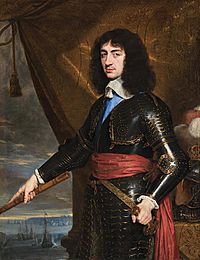Treaty of Breda (1650) facts for kids

Charles II of England, c. 1653
|
|
| Signed | 1 May 1650 |
|---|---|
| Location | Breda, Dutch Republic |
| Parties | Charles II; Kingdom of Scotland |
| Languages | English |
The Treaty of Breda (1650) was an important agreement signed on May 1, 1650. It was made between Charles II, who was the exiled king of England, Scotland, and Ireland, and the Scottish Covenanter government. The Covenanters were a group in Scotland who strongly supported a specific type of Protestant church called Presbyterianism.
Under this treaty, the Scots agreed to make Charles II their king. In return, Charles promised to make the Church of England Presbyterian. He also agreed to protect the rights of the Church of Scotland. This agreement led to a war between England and Scotland (1650–1652). Scotland lost this war and became part of the English Commonwealth. Even though Scotland later became independent again in 1660, Charles II did not keep his promise about the church. He brought back bishops to the Church of Scotland in 1662.
Contents
Why the Treaty Was Needed
Before this treaty, Scotland was controlled by the Covenanters. They had won wars in 1639 and 1640, which made their Presbyterian church, called the "kirk," very strong. Their main goal was to keep their church safe. They thought helping their English friends create a similar church in England would help.
This led to an agreement in 1643 called the Solemn League and Covenant. In this deal, the English Parliament agreed to protect the Scottish church. They also promised to change the Church of England to be more like it. In return, Scotland would send soldiers to help England.
Problems with the Agreement
However, not everyone in England liked this plan. Some religious groups, like the Independents, did not want a state-controlled church. Oliver Cromwell, a powerful leader, was one of these Independents. His army, the New Model Army, became very strong. By 1646, the Scots and their English allies saw Cromwell's group as a bigger problem than the Royalists. The Royalists were supporters of the king.
In 1646, Charles I, the king, tried to use these disagreements to his advantage. He gave himself up to the Scots, hoping they would give him better terms than the English Parliament. But Charles I refused to become Presbyterian. This caused a deadlock. In 1647, the Scots handed him over to the English Parliament for a large sum of money.
Scottish Concerns
The Scots felt left out of important talks by the English Parliament. By 1647, they worried they wouldn't achieve their goals. These goals included making Presbyterianism the main religion in England, Scotland, and Ireland. They also wanted to make sure the Scottish Parliament and church leaders had civil power. Some Scots even thought the English Parliament might take over Scotland.
Because of these worries, one group of Covenanters, called the Engagers, made a secret deal with Charles I. But their attempt to invade England failed. They even fought with other Covenanters who wanted a different deal with the king.
The Treaty of Breda
When Charles I was executed in 1649, his son, Charles II, was living in exile in Breda. A group of Covenanters, known as the "Kirk Party," decided to make a new deal with Charles II.
The Treaty of Breda gave the Kirk Party almost everything they wanted. Charles II promised to make Presbyterianism the national religion. He also agreed to accept the authority of the Kirk's General Assembly in England, just as it was in Scotland. Charles also took the Solemn League and Covenant oath from 1643.
What Happened Next
Charles II was crowned King of Scots in Scone in January 1651. But by then, the promises made at Breda were already broken. The Kirk Party's army was defeated by Oliver Cromwell at the Battle of Dunbar in September 1650. The English army then took over Edinburgh and much of Scotland.
Even when different Scottish groups tried to work together, it wasn't enough to help Charles get his throne back. He lost another battle in September 1651 and had to escape to France.
Under the Commonwealth of England, Scotland became part of England. Its law-making bodies were removed. Presbyterianism was no longer the official state religion. People had freedom of religion, except for Roman Catholics. However, the rules made by the Scottish church were no longer enforced by law.
After Charles II became king again in 1660, he completely ignored the Treaty of Breda. He wanted to bring back a church structure with bishops in Scotland.

